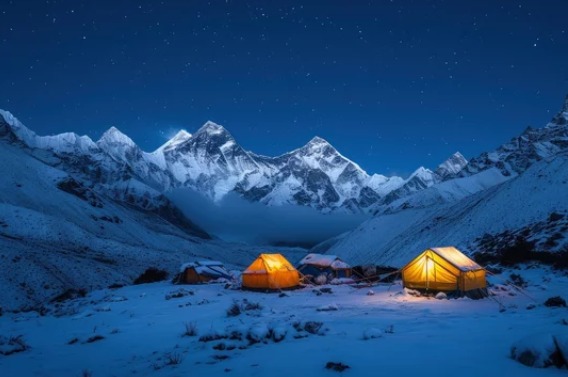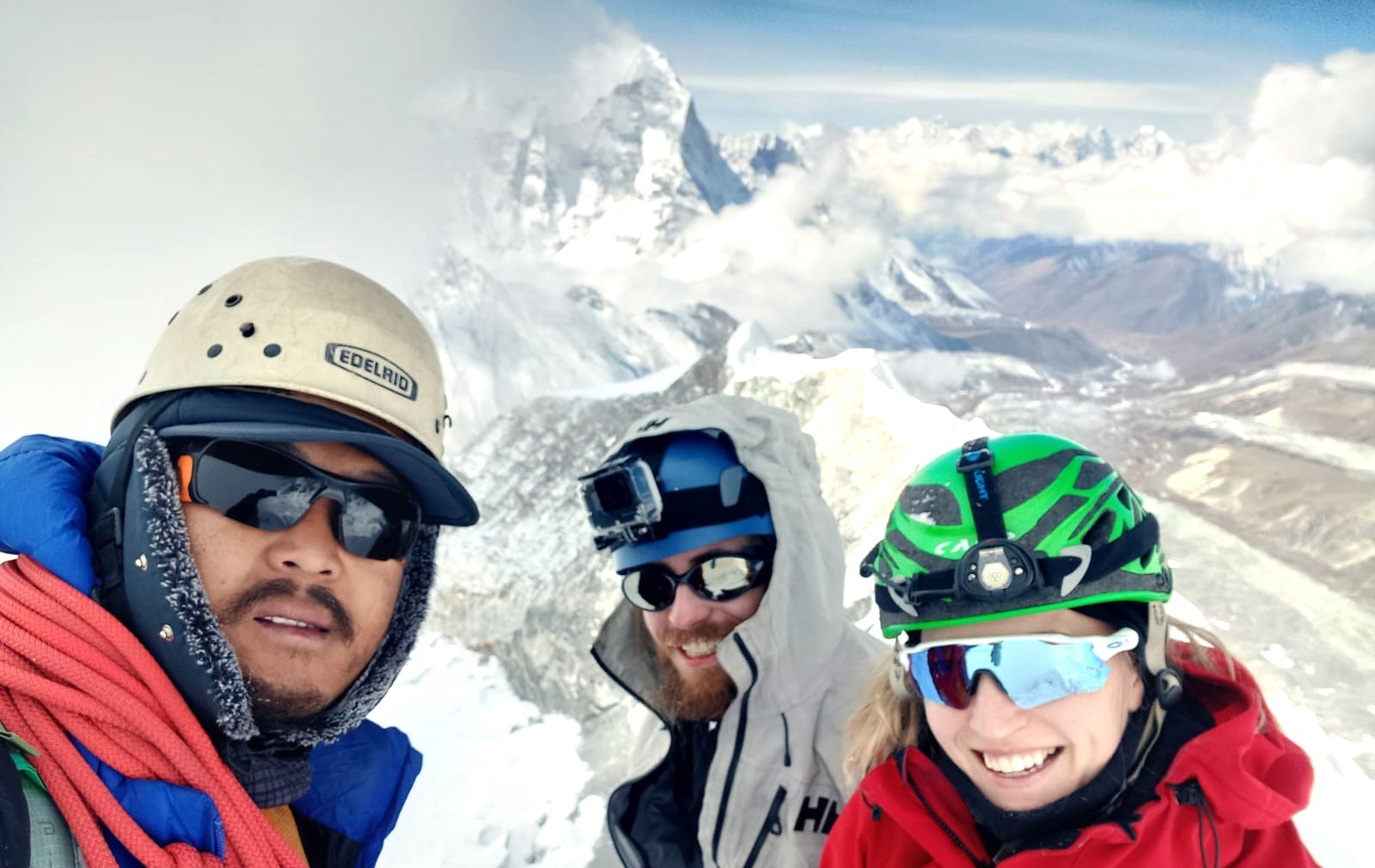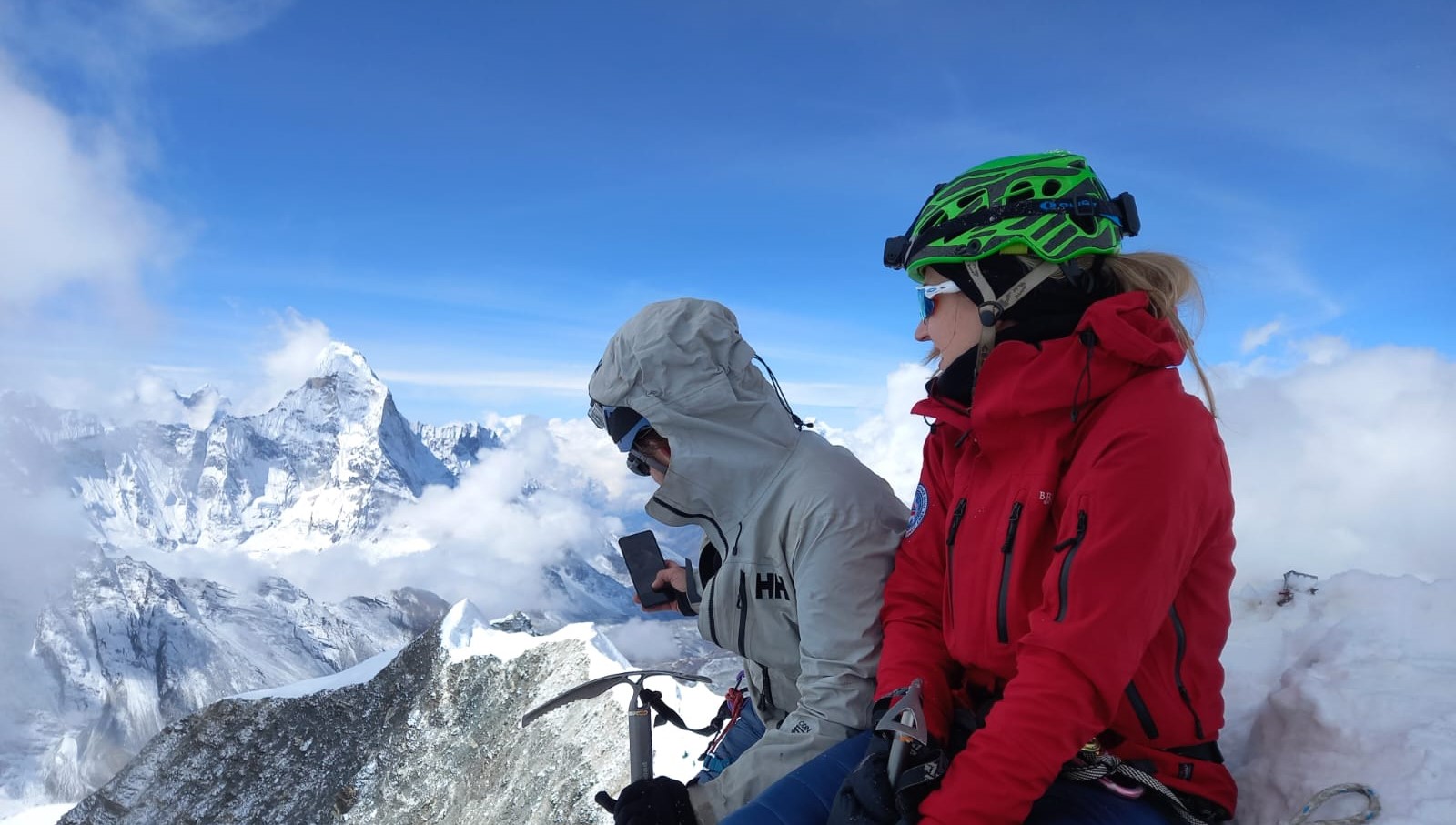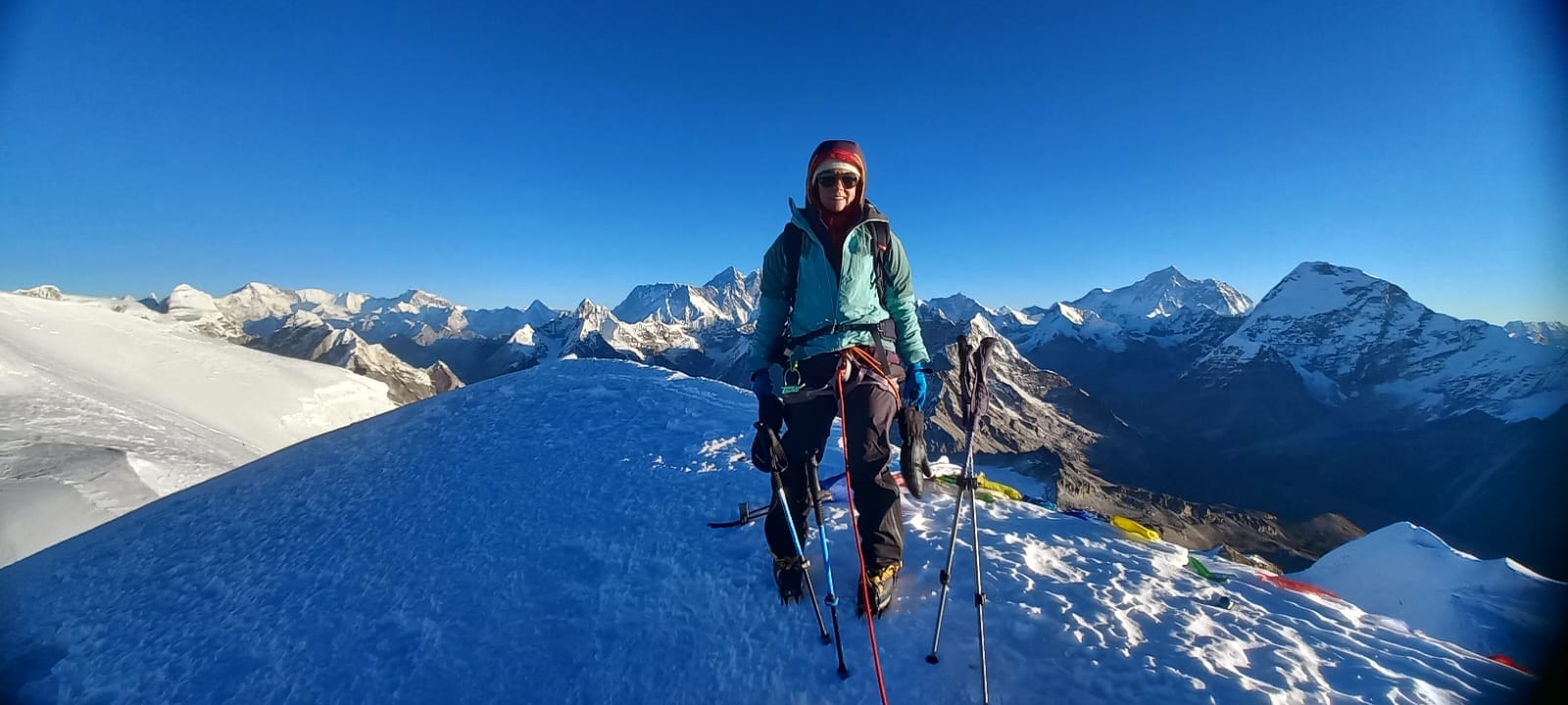26th August, 2025

Apr 01, 2024
Island Peak Climbing In April
- I am a Beginner Climber, Can I Do This Climb?
- How Hard is Climbing Island Peak?
- Distance of Island Peak
- Why Island Peak in April
- What Time of Year is Best to Climb Island Peak?
- What is the Weather Like on Island Peak in April?
- How Long Does It Take to Climb Island Peak?
- Challenges of Climbing Island Peak in April
- Suggestions for Your Island Peak Climbing in April Trip
- Highlights of Island Peak Climbing in April
- Island Peak Climbing Duration
- Permit for Island Peak Climbing
- Final Say
- Island Peak Climbing Packages
In April, Island Peak, also known as Imja Tse, emerges as a compelling challenge amidst the majestic Himalayas of Nepal. Standing tall at 6,189 meters (20,305 feet), this iconic peak offers an exhilarating climbing adventure set against breathtaking vistas of the Everest region.
April marks the onset of the peak climbing season in Nepal, making it an ideal time for ascending Island Peak. The weather during this month is generally stable and clear, with mild temperatures and relatively low precipitation. This creates favorable conditions for climbers, allowing for safer ascents and clearer views of the surrounding landscapes.
The journey to Island Peak typically begins with a thrilling flight from Kathmandu to Lukla, where the trekking adventure commences. Trekkers traverse through lush rhododendron forests, picturesque Sherpa villages, and across suspension bridges over roaring rivers, gradually acclimatizing as they gain altitude towards Everest Base Camp.
The climb to Island Peak itself involves a mixture of trekking and technical climbing. Before attempting the summit, climbers undergo thorough preparations and training under the guidance of experienced Sherpa guides. This includes learning essential mountaineering skills such as ice axe handling, rope techniques, and crevasse navigation.

ISLAND PEAK CLIMBING
Sherpa Expedition & Trekking (Est.1977) are pleased to announce FOR ADVENTURERS the most awesome, exhilarating & unforgettable climbing and treks on offer anywhere today!...
The ascent to the summit usually begins in the early hours of the morning, under a blanket of stars and with headlamps illuminating the path ahead. As climbers ascend the steep slopes, they are rewarded with awe-inspiring views of towering Himalayan peaks including Lhotse, Nuptse, and of course, Mount Everest itself. The final stretch involves navigating through glaciated terrain, often requiring careful footwork and determination.
Reaching the summit of Island Peak is a moment of immense accomplishment and joy for climbers, offering panoramic views that extend across the Khumbu region. The descent back to Base Camp allows for reflection on the achievement while taking in the beauty of the Himalayan landscape from a different perspective.
Throughout the expedition, climbers are immersed in the rich Sherpa culture, encountering traditional Buddhist monasteries, prayer flags fluttering in the wind, and warm hospitality from local communities. The camaraderie forged among team members during the trek and climb creates lasting memories and bonds.
April's favorable weather conditions, combined with the thrill of conquering Island Peak, make this month an excellent choice for adventurers seeking a challenging yet rewarding Himalayan climbing experience. Whether you are a seasoned mountaineer or embarking on your first high-altitude expedition, Island Peak in April promises an unforgettable adventure amidst some of the world's most spectacular landscapes.
I am a Beginner Climber, Can I Do This Climb?
If you're a beginner climber with a strong determination to challenge yourself, Island Peak can be a feasible goal. While prior trekking experience and basic fitness are essential, technical climbing skills can be learned during the expedition with the guidance of experienced Sherpa guides. It's crucial to undergo thorough training and acclimatization before attempting the summit to ensure safety and success. With proper preparation and a positive mindset, many beginners have successfully conquered Island Peak, enjoying the rewarding experience and stunning Himalayan vistas.
How Hard is Climbing Island Peak?
Climbing Island Peak is considered moderately difficult. It involves a combination of trekking through varied terrain and technical climbing on steep slopes and glaciated sections. The ascent to the summit requires basic mountaineering skills such as using crampons, ice axes, and ropes. The challenge lies in acclimatizing to the high altitude and navigating through potentially challenging weather conditions. However, with the support of experienced guides and adequate physical preparation, climbers with determination and perseverance can achieve their goal of reaching the summit of Island Peak.

ISLAND PEAK EXPEDITION 15 DAYS
Island Peak, also known as Imja Tse, is a popular peak located in the Khumbu region of Nepal. This peak is a part of the Himalayas and stands tall at a height of 6,189 meters above sea level. Island P...
Distance of Island Peak
The trekking distance to Island Peak varies depending on the chosen route and starting point. Typically, the journey begins with a flight from Kathmandu to Lukla, followed by a trek through the Everest region. From Lukla, trekkers usually follow the classic route to Everest Base Camp, covering approximately 130 kilometers (81 miles) round-trip. The trek to Island Peak Base Camp from Dingboche is about 10 kilometers (6.2 miles), and the climb to the summit and back can add another 20 kilometers (12.4 miles). Overall, the total distance trekked can range from 140 to 160 kilometers (87 to 99 miles) depending on the specific itinerary and side trips.
Why Island Peak in April
April is considered one of the best months to climb Island Peak due to favorable weather conditions. The weather in April is generally stable with mild temperatures and clear skies, offering excellent visibility of the surrounding Himalayan peaks. The low precipitation and calm winds during this period create optimal climbing conditions, enhancing safety and enjoyment for climbers. Additionally, April coincides with the peak trekking season in Nepal, providing opportunities to experience the vibrant local culture and breathtaking landscapes along the journey.
What Time of Year is Best to Climb Island Peak?
The best time to climb Island Peak is during the pre-monsoon (spring) season from April to May and the post-monsoon (autumn) season from late September to early November. These periods offer stable weather conditions with clear skies, making them ideal for climbing. Spring months like April are particularly popular due to mild temperatures, minimal precipitation, and vibrant landscapes with blooming rhododendrons. Climbers can enjoy breathtaking views of the Himalayas and experience the rich cultural heritage of the Everest region during these peak seasons.

ISLAND PEAK EXPEDITION 14 DAYS
Island Peak Expedition is a 14-day adventure tour that takes you to the heart of the Himalayas, where you can witness the beauty of the mountains, valleys, and glaciers. Island Peak, also known as Imj...
What is the Weather Like on Island Peak in April?
In April, the weather on Island Peak is generally mild and stable, making it an excellent time for climbing. Daytime temperatures at lower altitudes can range from 10 to 20 degrees Celsius (50 to 68 degrees Fahrenheit), while temperatures drop as altitude increases. Nights and early mornings are colder, with temperatures often below freezing. The skies are typically clear, offering spectacular views of the surrounding Himalayan peaks, including Mount Everest. However, weather conditions in the mountains can change rapidly, so climbers should be prepared for variable weather and pack accordingly with appropriate gear for cold temperatures and potential snowfall.
How Long Does It Take to Climb Island Peak?
The duration to climb Island Peak varies depending on the chosen itinerary and climber's fitness level. Typically, the entire expedition, including trekking to Base Camp, acclimatization days, summit attempt, and descent, takes around 16 to 20 days. This allows sufficient time for gradual acclimatization to high altitudes, essential for avoiding altitude sickness. The climb to the summit of Island Peak itself usually takes 1 to 2 days, depending on weather conditions and the pace of the climbers. Experienced climbers may complete the ascent and descent in a single long day, while others may opt for a more relaxed approach with an overnight stay at High Camp before summiting.

ISLAND PEAK SUMMIT RETURN BY HELICOPTER
Many of us only dream of standing on a tall peak looking down on the world. This is a great climb that will satisfy this desire. Island Peak, also referred to as Imja Tse, is a 6187-meter high peak in...
Challenges of Climbing Island Peak in April
Climbing Island Peak in April presents several challenges despite its favorable weather conditions:
- Weather Variability: While April generally offers stable weather, conditions can change unexpectedly in the mountains. Rapid weather changes may bring sudden snowfall or high winds, impacting visibility and climbing conditions.
- High Altitude: Island Peak stands at 6,189 meters (20,305 feet), requiring climbers to acclimatize properly to avoid altitude sickness. Adequate rest days and a gradual ascent are crucial for adjusting to the thin air at higher altitudes.
- Technical Climbing: The ascent involves technical sections such as steep slopes and glaciated terrain. Climbers need basic mountaineering skills and may encounter challenging ice and rock formations that require careful navigation.
- Physical Endurance: The trek to Island Peak Base Camp and the subsequent climb to the summit are physically demanding. Climbers should be prepared for long hours of trekking and strenuous climbing, often in harsh mountain conditions.
- Logistical Considerations: Proper equipment, including crampons, ice axes, and ropes, is essential. Additionally, arranging permits, guides, and accommodation in the Everest region during the peak season requires careful planning.
Suggestions for Your Island Peak Climbing in April Trip
Here are some tips to enhance your Island Peak climbing experience in April:
- Training and Preparation: Prioritize physical fitness and endurance training months before your trip. Focus on cardiovascular exercises, strength training, and hiking to build stamina.
- Acclimatization: Plan for adequate acclimatization days during your trek. Ascend slowly, hydrate well, and listen to your body's signals to prevent altitude sickness.
- Gear and Equipment: Ensure you have high-quality gear suitable for mountain conditions, including warm clothing, waterproof layers, sturdy boots, and essential climbing equipment. Renting or purchasing gear in Kathmandu is possible if needed.
- Stay Hydrated and Nourished: Maintain a balanced diet and drink plenty of water throughout your trek to support your energy levels and aid acclimatization.
- Follow Local Guidance: Listen to your experienced Sherpa guides who are familiar with the terrain and weather patterns. They will ensure your safety and provide valuable insights into the local culture.
Highlights of Island Peak Climbing in April
Climbing Island Peak in April offers unforgettable experiences and breathtaking highlights:
- Panoramic Views: Clear skies in April provide stunning views of Mount Everest and neighboring peaks from Island Peak's summit. Witness sunrise and sunset over the Himalayas for awe-inspiring moments.
- Spring Landscapes: The Everest region comes alive with blooming rhododendrons and other colorful flowers in April, adding vibrant hues to the trekking routes.
- Cultural Immersion: Encounter Sherpa culture and traditions as you pass through picturesque villages like Namche Bazaar and Dingboche. Visit monasteries adorned with prayer flags and learn about local customs from friendly villagers.
- Adventure and Achievement: Island Peak's summit presents a challenging yet achievable goal for climbers. Celebrate your accomplishment with fellow climbers and cherish lifelong memories of conquering a Himalayan peak.
- Wildlife Encounters: Keep an eye out for Himalayan wildlife such as musk deer, mountain goats, and various bird species along the trekking trails, adding a touch of wilderness to your journey.
Climbing Island Peak in April combines adventure, natural beauty, and cultural immersion, making it a truly rewarding experience for adventurous souls seeking to explore the Himalayas.
How To Reach Island Peak?
Reaching Island Peak involves a journey through the heart of the Everest region in Nepal. Here’s a typical route:
- Flight to Lukla: Start with a scenic flight from Kathmandu to Lukla, a small town in the Khumbu region.
- Trek to Namche Bazaar: Trek through picturesque Sherpa villages and lush forests to Namche Bazaar, a bustling town and gateway to the Everest region.
- Trek to Dingboche: Continue trekking along the Everest Base Camp trail, passing through villages like Tengboche and Pangboche, eventually reaching Dingboche, where climbers usually acclimatize.
- Trek to Island Peak Base Camp: From Dingboche, trek to Island Peak Base Camp, located near Chhukung village, where climbers prepare for the ascent.
- Summit Attempt: Climb from Base Camp to High Camp and then make the final ascent to Island Peak’s summit. Descend back to Base Camp and trek back to Lukla via the same route.
Island Peak Climbing Duration
The duration for climbing Island Peak typically ranges from 16 to 20 days. Here’s a breakdown:
- Trekking to Base Camp: 7 to 9 days, depending on the chosen itinerary and acclimatization schedule.
- Acclimatization and Preparation: Spend a few days at Base Camp for rest, training, and final preparations before attempting the summit.
- Summit Attempt: 1 to 2 days for the summit push, including climbing from Base Camp to High Camp and then to the summit, followed by descent back to Base Camp.
- Return Trek: Trek back to Lukla from Base Camp, usually taking 2 to 3 days.
Permit for Island Peak Climbing
To climb Island Peak, climbers need the following permits:
Sagarmatha National Park Entry Permit: Required for entering the Everest region. The cost is NPR 3,000 (approximately USD 30) per person.
Island Peak Climbing Permit: Issued by the Nepal Mountaineering Association (NMA). The cost varies depending on the season and group size but typically ranges from USD 350 to USD 500 per person.
TIMS Card (Trekker's Information Management System): Required for trekking in Nepal. The cost is USD 20 for individual trekkers and USD 10 for organized trekkers.

Three Peak Expedition
Embark on an unforgettable journey to the heart of the Himalayas as you conquer three majestic peaks: Mera Peak, Island Peak, and Lobuche Peak. This ultimate adventure combines technical climbing, bre...
Final Say
Climbing Island Peak in Nepal is a challenging yet rewarding adventure that combines trekking through stunning Himalayan landscapes with technical mountaineering. Preparation is key, both physically and mentally, to successfully summit this iconic peak. With proper training, acclimatization, and guidance from experienced Sherpa guides, climbers can achieve their goal and enjoy breathtaking views of the Everest region from Island Peak’s summit. The journey not only tests one’s limits but also offers cultural insights and unforgettable experiences amidst the world’s highest mountains.
Island Peak Climbing Packages
Island Peak Summit Return By Helicopter
Island Peak Expedition 14 Days
Island Peak Expedition 15 Days
Everest Three Pass with Island Peak Climbing

CHULU WEST PEAK CLIMBING
Fulfill that inner craving to succeed and test your limits! Climb your way to 6419 meters.Make your way to the beautiful Annapurna region and climb Chulu West (6419m) and mark this off your list of th...
Any Questions? Let Us Know.
Recent Posts
17th June, 2025


















